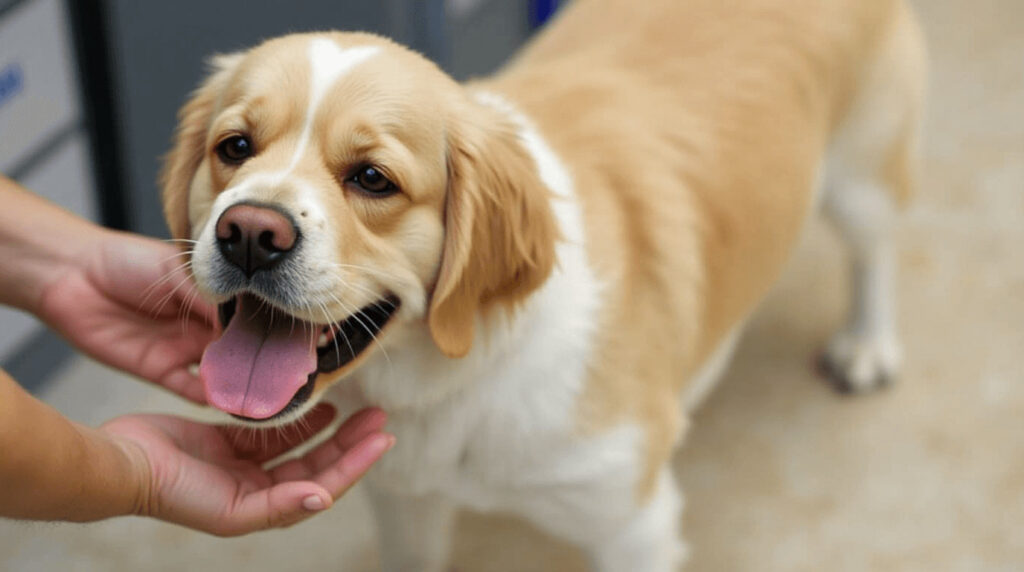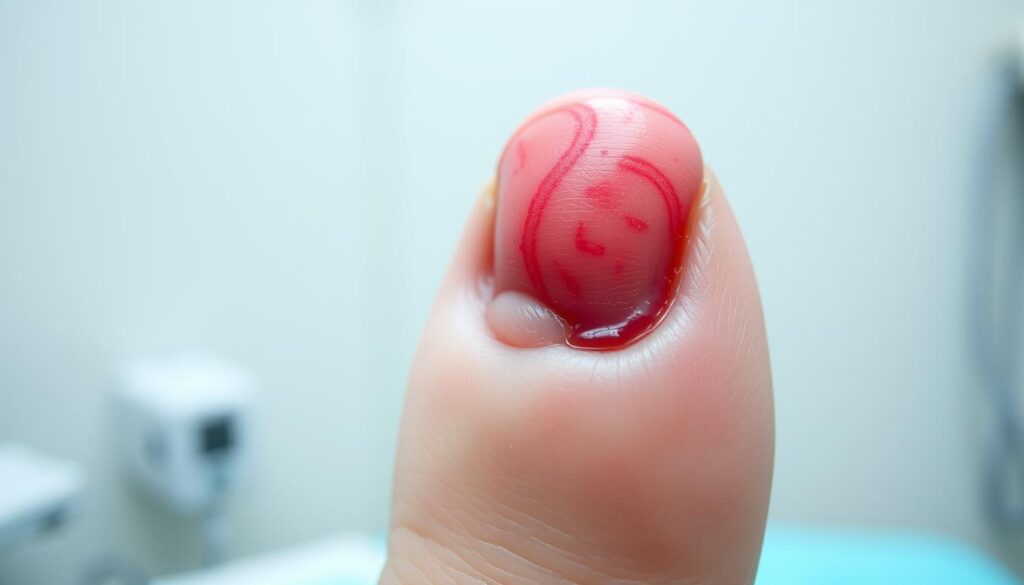As a dog owner, it’s crucial to know about canine paraphimosis. This serious condition affects your dog’s health and needs quick care. Paraphimosis can harm your dog’s well-being, so it’s important to spot its signs and get vet help.

It’s key to understand canine paraphimosis to keep your dog healthy. Knowing the signs helps you act fast to protect your dog. Good pet care means watching for health issues like paraphimosis and acting quickly.
Key Takeaways
- Canine paraphimosis is a serious condition that requires prompt veterinary attention.
- Recognizing the symptoms of paraphimosis is crucial to protecting your dog’s health.
- Effective pet care involves being aware of potential health issues, including canine paraphimosis.
- Dog health can be impacted by various factors, including paraphimosis.
- Prompt treatment is essential to preventing complications and ensuring your dog’s well-being.
- Regular veterinary check-ups can help identify potential health issues, including canine paraphimosis.
Understanding Paraphimosis in Dogs
As a dog owner, knowing about health issues is key. Paraphimosis is a serious condition that needs vet attention fast. It happens when a dog’s penis gets stuck outside its sheath, causing swelling and pain.
Keeping your dog healthy is vital to avoid paraphimosis. Knowing the risks and symptoms helps you act quickly. This ensures your dog gets the care they need to stay well.

Some dog breeds are more likely to get paraphimosis because of their body shape. Knowing this can help you prevent it. Working with vets and focusing on your dog’s health can keep them happy and healthy.
When thinking about paraphimosis risks, consider these:
- Breed and anatomy
- Age and health status
- Environmental factors and lifestyle
Being informed and getting regular vet check-ups can help prevent paraphimosis. This way, you ensure your dog gets the best care.
Signs and Symptoms to Watch For
As a dog owner, it’s key to know the signs of paraphimosis. This is to get your dog to the vet quickly. Paraphimosis treatment is important to avoid more problems. Watch your dog’s health closely and get vet help if you see swelling, redness, or discharge.
Some common dog paraphimosis symptoms are pain and discomfort. This can make your dog whine, pant, or act restless. If you see these signs, it’s important to talk to a vet about treatment.
Here are some key signs to watch for:
- Swelling and redness around the affected area
- Discharge or bleeding
- Pain or discomfort when urinating or defecating
- Changes in appetite or water intake
- Behavioral changes, such as whining or restlessness

Early detection and treatment are key in managing paraphimosis. By spotting the signs and symptoms early, you can prevent more issues. If you think your dog has paraphimosis, get vet help right away for the right diagnosis and treatment.
Common Causes of Paraphimosis
As a dog owner, it’s important to know why paraphimosis happens. This knowledge helps in preventing paraphimosis in dogs and keeping them healthy. Paraphimosis can be caused by physical harm, health issues, or environmental factors. Knowing these causes lets you take steps to keep your dog safe and healthy.
Some common causes of paraphimosis include:
- Physical trauma, such as injury or irritation to the penis or prepuce
- Medical conditions, such as urinary tract infections or tumors
- Environmental factors, such as extreme temperatures or exposure to irritants
Knowing these causes is key to preventing paraphimosis in your dog. Regular vet visits and good dog health habits can lower the risk. By understanding paraphimosis causes, you can protect your dog and help them live a happy, healthy life.
Being informed and proactive can protect your dog from paraphimosis. This ensures their dog health and well-being.
When to Consider This a Medical Emergency
As a dog owner, it’s key to know when your dog needs urgent vet care. Canine paraphimosis can get worse and even be life-threatening if not treated quickly. Look for these signs to know when to rush to the vet:
- Severe swelling or bleeding
- Pain or discomfort when urinating
- Difficulty walking or standing
- Lack of appetite or vomiting
Quick vet care is vital to avoid serious problems. Canine paraphimosis needs fast treatment to prevent infections, tissue damage, or organ failure. Always talk to a vet for the right diagnosis and treatment.
Your dog’s health is in your hands. Recognizing medical emergencies is crucial. Quick vet visits can help your dog recover from canine paraphimosis. In vet medicine, every second counts. Fast action is key to your dog’s health and happiness.
Diagnosing Paraphimosis at the Vet
As a responsible dog owner, knowing how to diagnose paraphimosis is key. When you take your dog to the vet, they will do a detailed check. This check helps figure out how bad the paraphimosis is and what might have caused it.
The vet will look at the penis and the area around it closely. They might also do a digital rectal examination to check for other health issues. This helps keep your dog healthy and speeds up their recovery.
Your vet might also suggest more tests to confirm the diagnosis. As a dog owner, knowing the value of regular health checks is important. Working with your vet ensures your dog gets the best care.
Some common tests include:
- Urinalysis to check for urinary tract infections
- Blood tests to check for underlying medical conditions
- Imaging studies, like X-rays or ultrasound, to look at the affected area
Understanding the diagnostic process and working with your vet is crucial. It ensures your dog gets the best care. Remember, your dog’s animal wellness is vital for their health and happiness.
Treatment Options and Management
As a dog owner, knowing how to treat paraphimosis is key. This condition affects dog health and needs the right pet care. The treatment depends on how bad the condition is. It might include manual reduction, medication, or surgery.
Treatment options include:
- Manual reduction: A procedure where the veterinarian manually pushes the prolapsed tissue back into place.
- Medication: Administering medication to reduce swelling and pain.
- Surgery: In severe cases, surgery may be necessary to correct the condition.
It’s important to work with your vet to find the best treatment for your dog. With the right pet care and following your vet’s advice, your dog can get better. This will also boost their overall dog health.
Home Care and Recovery Tips
When your dog is recovering from paraphimosis, it’s key to take good care at home. Make sure their space is safe and comfy. This helps them relax and lowers the chance of dog paraphimosis symptoms getting worse.
To stop paraphimosis from happening again, regular vet visits and good hygiene are important. Here are some tips for your dog’s recovery:
- Clean the affected area gently with mild soap and lukewarm water to prevent infection.
- Apply a topical antibiotic ointment to reduce the risk of bacterial infection.
- Restrict your dog’s activity to prevent further irritation and promote healing.
Watching your dog closely is crucial for a smooth recovery. Look out for signs of infection like redness, swelling, or discharge. If you see these, call your vet right away. By following these tips, you can help your dog get better and avoid future problems.
Preventing Future Episodes
To lower the chance of canine paraphimosis, start by making lifestyle changes. Feed your dog a balanced diet and ensure they get enough exercise. Keeping them at a healthy weight is also important.
Regular health checks are key to stopping future paraphimosis. Take your dog to the vet often to catch health problems early. Your vet can suggest diet and exercise changes to help prevent paraphimosis. Veterinary medicine has improved a lot, and your vet can give advice just for your dog.
Some important ways to stop paraphimosis include:
- Feeding a balanced and nutritious diet
- Ensuring regular exercise and mental stimulation
- Maintaining a healthy weight
- Scheduling regular veterinary check-ups
By following these tips and working with your vet, you can lower the risk of paraphimosis. This way, your dog can live a happy and healthy life. Remember, prevention is key. Taking proactive steps can help prevent future paraphimosis and keep your dog healthy.
Potential Complications if Left Untreated
As a dog owner, knowing the risks of paraphimosis is key. If you think your dog has it, get medical help fast. Untreated, it can cause serious problems like infections, tissue damage, and even life-threatening issues. This is very bad for your dog’s health and happiness.
It’s important for dog owners to know the dangers of not treating paraphimosis quickly. Some serious problems that can happen include:
- Infection: Bacteria can get into the exposed tissue, causing infection and possibly sepsis.
- Tissue damage: The penis being exposed for too long can damage the tissue, causing scars and permanent harm.
- Life-threatening conditions: In very bad cases, paraphimosis can cause serious problems like gangrene or septicemia.
It’s vital to look after your dog’s health and get vet help right away if you think they have paraphimosis. This way, you can stop these serious problems and make sure your dog gets the care they need.
As a caring dog owner, it’s your job to keep your dog healthy and happy. Knowing about the dangers of paraphimosis and getting help quickly can protect your dog’s health and prevent lasting harm.
When to Schedule Follow-up Veterinary Visits
As a responsible pet owner, keeping your dog’s health a top priority is key, especially after a paraphimosis diagnosis. Regular vet visits are crucial to track your dog’s healing and avoid future issues. Working closely with your vet ensures your dog gets the best care and stays healthy.
Keep a close eye on your dog’s recovery, watching for any complications or setbacks. Look for changes in behavior, appetite, or physical condition. Being proactive and attentive helps your dog recover fast and lowers the risk of future problems.
- Reduction in swelling and pain
- Improved urinary function
- Return to normal appetite and activity level
If you see warning signs like increased pain, bleeding, or trouble urinating, get vet help right away. By focusing on your dog’s recovery and providing the right care, you can help them heal quickly and avoid future paraphimosis episodes.
Conclusion: Managing Your Dog’s Health and Recovery
Managing your dog’s health and recovery from paraphimosis is a team effort. It needs your dedication and careful attention. By understanding the condition and recognizing signs, you can help your dog live a healthy and happy life.
By following the preventive steps in this article, you can lower the risk of future paraphimosis. Remember, taking care of your dog is a shared task. Being informed and proactive ensures they get the best care.
While your dog recovers, watch for any warning signs and act fast. Following the home care tips helps your pet heal and grow strong. Celebrate each step and keep in touch with your vet for a successful recovery.
Your dog’s health and happiness are top priorities. With the knowledge from this article, you can manage paraphimosis and strengthen your bond with your pet.
FAQ
What is paraphimosis in dogs?
Paraphimosis is when a dog’s penis gets stuck outside its prepuce. This causes swelling, pain, and can lead to serious problems.
How common is paraphimosis in dogs?
Paraphimosis is not very common in dogs. It can happen in some breeds or due to certain health or environmental factors.
Which dogs are most at risk of developing paraphimosis?
Dogs with flat faces and older dogs are more likely to get paraphimosis. This is because of their body shape or age.
What are the common signs and symptoms of paraphimosis in dogs?
Signs include swelling, redness, and discharge around the penis. Dogs may also lick or bite the area.
What are the common causes of paraphimosis in dogs?
It can be caused by injury, medical issues, or environmental factors. Things like foreign objects or too much licking can cause it.
When should paraphimosis be considered a medical emergency?
It’s an emergency if the penis is very swollen, discolored, or if the dog is in a lot of pain. These are signs of serious problems.
How is paraphimosis diagnosed at the veterinary clinic?
Vets diagnose it by examining the dog. They might also do tests to find the cause.
What are the treatment options for paraphimosis in dogs?
Treatment can be manual reduction, medicine, or surgery. It depends on how bad it is and why it happened.
What kind of home care and recovery tips should dog owners follow?
Owners should clean the area, limit activity, and watch the dog closely. This helps with recovery.
How can dog owners prevent future episodes of paraphimosis?
Owners can prevent it by making lifestyle changes. This includes diet, exercise, and regular vet visits to catch health issues early.
What are the potential complications if paraphimosis is left untreated?
Untreated paraphimosis can cause serious problems. This includes infections, tissue damage, and even life-threatening conditions. It’s very important to get vet help quickly.
When should dog owners schedule follow-up veterinary visits for paraphimosis?
Owners should schedule follow-ups to check on the dog’s recovery. This helps catch any signs of problems and prevents it from coming back. The timing depends on the case and the vet’s advice.
